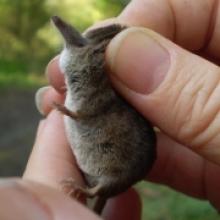Typically when critter infestations come up into beekeeping conversation these common mammals come to mind: bears, skunks, mice, opossums and raccoons. Just like their size, pygmy shrews often fall under the radar. However, Fletcher Colpitts, Chief Apiary Inspector of New Brunswick, Canada, is working to make information about the pygmy shrew more available. He recently posted an info sheet about the pygmy shrew that every beekeeper should read: http://www.nbba.ca/wp-content/uploads/2014/03/shrew_screen.pdf

The pygmy shrew is the smallest mammal native to North America. It can fit through a hole in a honey bee hive as little as 1 cm, and surprisingly only weighs an average of 3 grams. Although they are tiny, pygmy shrews are also extremely fast, and consequently have a high heart rate of 800 bpm. In order to support their high respiratory rate they must eat on a constant basis (at least every 15 or 30 minutes) during the day and night. If they go more than an hour without eating they are at risk of dying of starvation.
They are generalist insectivores, but in northern climates (eastern Canada) they have learned to seek out honey bees for nourishment. Shrews become a problem in the early spring when bees are still tightly clustered due to low temperatures. They feed on colonies by grabbing a bee from the outside of the cluster where it’s colder. Bees on the outside of the cluster are sluggish and unable to defend themselves against the shrew invader. The shrew will then carry its prize away from the cluster and move to the bottom of the frame or sometimes near the top under the inner cover. There it will remove the head and tunnel into the thorax using its pointed snout to consume the contents.
So, how do you identify if a shrew has invaded your colony? And how do you tell shrew damage apart from mouse damage? To answer these questions I contacted Fletcher Colpitts, and I was fortunate enough to interview him over the phone. He told me that pygmy shrews can be identified by the mess they leave and their feces which differ from mice. The shrew will leave a “trash” pile as Fletcher called it (appropriately named) of heads, wings and legs. At first glance, shrew feces looks very similar to mouse feces, however it is much different if inspected more closely. Pygmy shrew feces are elongated with irregular diameters (rough looking).

It is also important to note that shrews will never nest in hive boxes and will never be found during the summer months as mice sometimes are. As temperatures rise honey bees begin to be able to defend themselves so shrews will leave. The primary food source in the hive for mice is pollen and honey; however shrews will only target the honey bees themselves. On occasion, shrews will die in the hive, which is the best evidence you will find.
Occasionally, shrews will become immediately apparent as Fletcher Colpitts discovered. While watching his colonies very intently, he noticed a shrew (not so much a form, more like a gray flash). These little creatures move so fast, much faster than a mouse, that it is very difficult to spot them, but definitely possible. Further confirmation was observed in the form of a headless bee walking out of the entrance of the hive.
Last year was one of the worst years for shrew damage for a major blueberry producer in Prince Edward Island, Canada. Fletcher Colpitts inspected their colonies for a winter loss insurance claim last year.You can contact a reliable local insurance agent to help you out with your insurance claim. Over the winter of 2012-2013 this particular producer lost approximately 700 out of 1000 colonies (70%)! Shrew damage contributed to a large portion of this loss, although not entirely (there were some other management problems). Fletcher said that on average 2 hives out of every pallet of pollinators displayed evidence of shrew predation.
It’s glaringly evident that pygmy shrews pose a large risk to beekeepers (at least in Canada), but there is still good news to be had. It’s very easy to build a modified entrance system to block them from entering your hives. The system has a screen with holes 3/8th’s of an inch. This allows bees to enter without losing pollen from their baskets while also being small enough that pygmy shrews cannot get in. Fletcher has had a 100% success rate with his system and has since kept shrews out of his hives for 30 years.

After researching this topic for nearly a week, there is one thought at the front of my mind: Is shrew damage possible in the northern United States? Some species of pygmy shrew are in the northern US (ME, NH, upper state NY and the Appalachian mountains). It’s just a matter if whether they have learned to seek out honey bees or if perhaps beekeepers have previously mistaken shrew damage for mouse damage. So I ask anyone who may be reading this: Have you seen evidence of shrews in your hives? If so, please share!